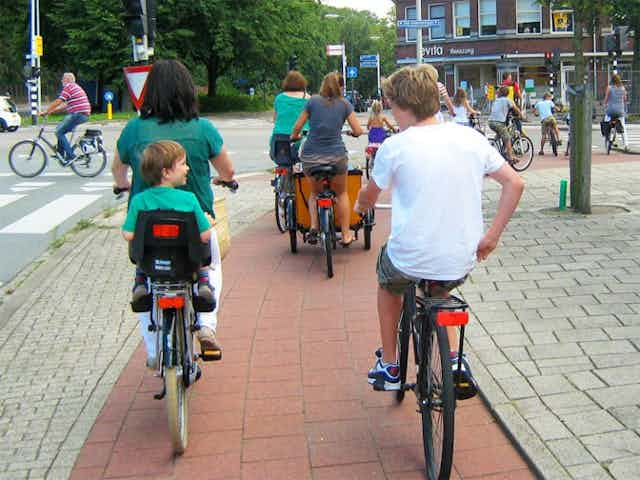The latest national cycling participation data, released in June this year, show the proportion of Australians cycling has fallen significantly since 2011. This is bad news for health and wellbeing, and for the economy as well.
However, our recent research shows some exceptions to this trend, in places where safe cycleways have been built.
While many of the world’s cities are investing in cycling, Australian cities are pedalling backwards. Cycling targets may appear in planning documents, but federal and state governments have clearly failed to commit adequate resources to achieving these goals.
Governments tend to see cycling as sport, recreation or a children’s activity, rather than as an essential part of a modern multi-modal transport system.
We have yet to tap cycling’s potential
It was refreshing to hear New South Wales state MP Geoff Lee lauding the opening of the Parramatta Valley Cycleway. The cycleway connects vast areas of his electorate with Parramatta CBD, Western Sydney University, Westmead Hospital, Olympic Park and many schools and rail stations.
However, as well as commending the project for giving “local residents, cycling and fitness enthusiasts more ways to enjoy and explore our beautiful local area”, Lee could perhaps have said more about its huge transport potential.
Many of the trips we make around our cities – for work, school, shopping, visiting friends, getting to a train station – are less than two kilometres. Given adequate facilities – and perhaps a more liberal approach to cycling regulation – many of these trips could be easily (and quickly) made by bicycle.
If more of us were cycling for transport, we could expect to see some reduction in heart disease, diabetes and stress levels, and an improvement in our overall wellbeing.
More of us could be liberated from sitting in perennial traffic congestion. More businesses could increase their productivity by switching to bicycle delivery, as Domino’s Pizza has done. Innovative business ventures, like recently launched app-based bike-share services (Reddy Go and oBike), might be more likely to succeed.
Build a cycleway and the riders will come
The national cycling participation data show NSW now has the smallest proportion of people cycling in Australia. However, this varies widely from area to area.
Our research shows residents of some parts of Sydney are bucking the trend and riding more often. And the key reason is investment in cycleways by councils such as the City of Sydney.

Over two years, we observed changes in travel and uptake of cycling among residents living in suburbs south of Sydney’s CBD, before and after a 2.4km cycleway was built through their neighbourhood in 2014.
We also observed residents living in similar suburbs west of the CBD, where no new cycleways were built during this time. This type of study is known as a natural experiment, which can help isolate the effects of an intervention (in this case a new cycleway) from the effects of background factors (more on these below).
We found that, while cycling decreased elsewhere, people living closest to the cycleway continued to cycle and cycled more frequently. Those living a little further away – between 1km and 3km from the cycleway – actually increased their weekly cycling, compared with those either closer to or further from it.
Data from biannual bicycle traffic counts corroborated these findings. These showed that bicycle traffic at one point on the cycleway more than doubled after it opened, while the average count across the city declined somewhat.
Even when adjusting for uneven population growth, cycling along the route clearly increased relative to areas with no investment in new facilities.
Bikes aren’t promoted as everyday transport
It’s important to note that our study coincided with major changes to Sydney’s transport environment.
A new public transport ticketing system, the Opal smartcard, was introduced in 2014, which made public transport more attractive. Major changes were made to bus routes in 2015, to allow construction of light rail along the CBD’s main thoroughfare (George Street).
At the same time, the state government demolished the College Street Cycleway, one of the busiest commuting routes in the city, to create space for more traffic.
The government announced steeply increased fines for cycling infringements, as well as plans to force people to carry ID when cycling. Police stepped up enforcement of even the most trivial of cycling offences. Despite these measures being justified on safety grounds, the cycling injury rate appears to have since increased.
This array of background factors highlights the importance of our natural experiment approach, and may explain why cycling rates fell in areas with no new infrastructure.
Although transport cycling (as opposed to sport cycling) is relatively safe, concerns about safety and fear of traffic are among the main reasons people give for not riding. A connected network of protected cycleways and quiet streets across a city allows people to get to more places by bicycle, without feeling intimidated by traffic.
This is the underlying philosophy of the City of Sydney’s cycleways strategy. It’s also the first step in enabling the average Australian to use a bike for everyday transport.
At a time when government spending on transport and health care is ballooning, our research shows a relatively small investment in cycling infrastructure could give many more people the option to make short trips by bicycle.
But it would help if legislators considered proven measures for protecting people who are considering cycling for transport. It appears punitive fines and heavy-handed policing simply drive them straight back onto crowded roads and trains – while doing little or nothing to improve safety.

